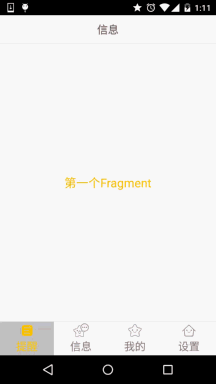本节引言:
上一节中我们使用LinearLayout + TextView实现了底部导航栏的效果,每次点击我们都要重置所有TextView的状态,然后选中点击的TextView,有点麻烦是吧,接下来我们用另一种方法:RadioGroup + RadioButton来实现我们上一节的效果!
1.一些碎碎念
本节用到的是实现单选效果的RadioButton,如果你不熟悉,或者没用过,可先移步到:RadioButton简单点说就是我们就是一个RadioGroup包着四个RadioButton,和前面一样用比例来划分:1:1:1:1;
另外我们只需重写RadioGroup的onCheckedChange,判断checkid即可知道点击的是哪个RadioButton!好的,下面开始堆码!
2.实现流程
PS:这里的素材什么的,直接使用的是上一节中的素材!另外drawable类的资源都是将selected状态修改成checked!
Step 1:写底部选项的一些资源文件
图片Drawable资源:tab_menu_channel.xml
<?xml version="1.0" encoding="utf-8"?><selector xmlns:android="https://schemas.android.com/apk/res/android"> <item android:drawable="@mipmap/tab_channel_pressed" android:state_checked="true" /> <item android:drawable="@mipmap/tab_channel_normal" /></selector>
其他三个照葫芦画瓢!
文字资源:tab_menu_text.xml
<?xml version="1.0" encoding="utf-8"?><selector xmlns:android="https://schemas.android.com/apk/res/android"> <item android:color="@color/text_yellow" android:state_checked="true" /> <item android:color="@color/text_gray" /></selector>
背景资源:tab_menu_bg.xml
<?xml version="1.0" encoding="utf-8"?><selector xmlns:android="https://schemas.android.com/apk/res/android"> <item android:state_selected="true"> <shape> <solid android:color="#FFC4C4C4" /> </shape> </item> <item> <shape> <solid android:color="@color/transparent" /> </shape> </item></selector>
Step 2:编写我们的Activity布局
在前面用TextView实现底部导航栏我们就发现了一个问题,每个TextView的属性都几乎是差不多的,而在建议那里我们也说让大家把相同的属性抽取出来写到Style中,可能部分朋友懒或者不知道如何抽取出来,以及用,这里就给大家示范下:
首先我们取出其中一个RadioGroup的标签:
<RadioButton android:id="@+id/rb_channel" android:layout_width="0dp" android:layout_height="match_parent" android:layout_weight="1" android:background="@drawable/tab_menu_bg" android:button="@null" android:drawableTop="@drawable/tab_menu_channel" android:gravity="center" android:paddingTop="3dp" android:text="@string/tab_menu_alert" android:textColor="@drawable/tab_menu_text" android:textSize="18sp" />
我们可以把每个RadioButton都相同的属性抽取出来,写到style.xml文件中:
<style name="tab_menu_item"> <item name="android:layout_width">0dp</item> <item name="android:layout_weight">1</item> <item name="android:layout_height">match_parent</item> <item name="android:background">@drawable/tab_menu_bg</item> <item name="android:button">@null</item> <item name="android:gravity">center</item> <item name="android:paddingTop">3dp</item> <item name="android:textColor">@drawable/tab_menu_text</item> <item name="android:textSize">18sp</item></style>
然后我们的activity_main.xml中的RadioButton就用不着次次都写相同的代码了,只需让RadioButton的style="@style/tab_menu_item"就可以了!
activity_main.xml:
<RelativeLayout xmlns:android="https://schemas.android.com/apk/res/android" xmlns:tools="https://schemas.android.com/tools" android:layout_width="match_parent" android:layout_height="match_parent" android:background="@color/bg_gray" tools:context=".MainActivity"> <RelativeLayout android:id="@+id/ly_top_bar" android:layout_width="match_parent" android:layout_height="48dp" android:background="@color/bg_topbar"> <TextView android:id="@+id/txt_topbar" android:layout_width="match_parent" android:layout_height="match_parent" android:layout_centerInParent="true" android:gravity="center" android:text="信息" android:textColor="@color/text_topbar" android:textSize="18sp" /> <View android:layout_width="match_parent" android:layout_height="2px" android:layout_alignParentBottom="true" android:background="@color/div_white" /> </RelativeLayout> <RadioGroup android:id="@+id/rg_tab_bar" android:layout_width="match_parent" android:layout_height="56dp" android:layout_alignParentBottom="true" android:background="@color/bg_white" android:orientation="horizontal"> <RadioButton android:id="@+id/rb_channel" style="@style/tab_menu_item" android:drawableTop="@drawable/tab_menu_channel" android:text="@string/tab_menu_alert" /> <RadioButton android:id="@+id/rb_message" style="@style/tab_menu_item" android:drawableTop="@drawable/tab_menu_message" android:text="@string/tab_menu_profile" /> <RadioButton android:id="@+id/rb_better" style="@style/tab_menu_item" android:drawableTop="@drawable/tab_menu_better" android:text="@string/tab_menu_pay" /> <RadioButton android:id="@+id/rb_setting" style="@style/tab_menu_item" android:drawableTop="@drawable/tab_menu_setting" android:text="@string/tab_menu_setting"/> </RadioGroup> <View android:id="@+id/div_tab_bar" android:layout_width="match_parent" android:layout_height="2px" android:layout_above="@id/rg_tab_bar" android:background="@color/div_white" /> <FrameLayout android:id="@+id/ly_content" android:layout_width="match_parent" android:layout_height="match_parent" android:layout_above="@id/div_tab_bar" android:layout_below="@id/ly_top_bar"></FrameLayout></RelativeLayout>
Step 3:隐藏顶部导航栏
AndroidManifest.xml设置下theme属性
android:theme="@style/Theme.AppCompat.NoActionBar"
Step 4:创建一个Fragment的简单布局与类:
直接照搬上一节的布局跟Fragment:
fg_content.xml:
<?xml version="1.0" encoding="utf-8"?><LinearLayout xmlns:android="https://schemas.android.com/apk/res/android" android:orientation="vertical" android:layout_width="match_parent" android:layout_height="match_parent" android:background="@color/bg_white"> <TextView android:id="@+id/txt_content" android:layout_width="match_parent" android:layout_height="match_parent" android:gravity="center" android:text="呵呵" android:textColor="@color/text_yellow" android:textSize="20sp"/></LinearLayout>
MyFragment.java:
/** * Created by Coder-pig on 2015/8/29 0028. */public class MyFragment extends Fragment { private String content; public MyFragment(String content) { this.content = content; } @Override public View onCreateView(LayoutInflater inflater, ViewGroup container, Bundle savedInstanceState) { View view = inflater.inflate(R.layout.fg_content,container,false); TextView txt_content = (TextView) view.findViewById(R.id.txt_content); txt_content.setText(content); return view; }}Step 5:编写MainActivity.java
这个比起TextView实现简单多了,就不详细讲解了,很简单,直接上代码:
MainActivity.java
/** * Created by Coder-pig on 2015/8/29 0028. */public class MainActivity extends AppCompatActivity implements RadioGroup.OnCheckedChangeListener{ private RadioGroup rg_tab_bar; private RadioButton rb_channel; //Fragment Object private MyFragment fg1,fg2,fg3,fg4; private FragmentManager fManager; @Override protected void onCreate(Bundle savedInstanceState) { super.onCreate(savedInstanceState); setContentView(R.layout.activity_main); fManager = getFragmentManager(); rg_tab_bar = (RadioGroup) findViewById(R.id.rg_tab_bar); rg_tab_bar.setOnCheckedChangeListener(this); //获取第一个单选按钮,并设置其为选中状态 rb_channel = (RadioButton) findViewById(R.id.rb_channel); rb_channel.setChecked(true); } @Override public void onCheckedChanged(RadioGroup group, int checkedId) { FragmentTransaction fTransaction = fManager.beginTransaction(); hideAllFragment(fTransaction); switch (checkedId){ case R.id.rb_channel: if(fg1 == null){ fg1 = new MyFragment("第一个Fragment"); fTransaction.add(R.id.ly_content,fg1); }else{ fTransaction.show(fg1); } break; case R.id.rb_message: if(fg2 == null){ fg2 = new MyFragment("第二个Fragment"); fTransaction.add(R.id.ly_content,fg2); }else{ fTransaction.show(fg2); } break; case R.id.rb_better: if(fg3 == null){ fg3 = new MyFragment("第三个Fragment"); fTransaction.add(R.id.ly_content,fg3); }else{ fTransaction.show(fg3); } break; case R.id.rb_setting: if(fg4 == null){ fg4 = new MyFragment("第四个Fragment"); fTransaction.add(R.id.ly_content,fg4); }else{ fTransaction.show(fg4); } break; } fTransaction.commit(); } //隐藏所有Fragment private void hideAllFragment(FragmentTransaction fragmentTransaction){ if(fg1 != null)fragmentTransaction.hide(fg1); if(fg2 != null)fragmentTransaction.hide(fg2); if(fg3 != null)fragmentTransaction.hide(fg3); if(fg4 != null)fragmentTransaction.hide(fg4); }}PS:在上一节忘记讲一点了,FragmentTransaction只能使用一次,每次使用都要调用FragmentManager的beginTransaction()方法获得FragmentTransaction事务对象哦!
3.运行效果图
其实和上一节实现的效果是一样的:

4.代码下载:
FragmentDemo2.zip:FragmentDemo2.zip 下载
5.本节小结:
本节讲解的是实现底部导航栏的第二种方法:RadioGroup + RadioButton,有了单选,我们就不用像TextView一样,每次点击后先重置所有TextView的Selected状态,再让点击的TextView的Selected为true,这样就可以写少一点代码了~本节就到这里~谢谢





